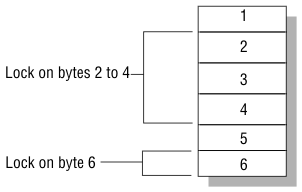
Rather than locking the entire smart large object, you can lock only a specific byte range of a smart large object. Byte-range locking is advantageous because it allows multiple users to update the same smart large object simultaneously, as long as they are updating different parts of it. Also, users can read a part of a smart large object while another user is updating or reading a different part of the same smart large object.
Figure 41 shows two locks placed on a single smart large object. The first lock is on bytes 2, 3, and 4. The second lock is on byte 6 alone.

The database server manages byte-range locks in the lock table in a similar fashion to other locks placed on rows, pages, and tables. However, the lock table must store the byte range as well.
If a user places a second lock on a byte range adjacent to a byte range that the user currently has locked, the database server consolidates the two locks into one lock on the entire range. If a user holds locks that Figure 41 shows, and the user requests a lock on byte five, the database server consolidates the locks placed on bytes two through six into one lock.
Likewise, if a user unlocks only a portion of the bytes included within a byte-range lock, the database server might be split into multiple byte-range locks. In Figure 41, the user could unlock byte three, which causes the database server to change the one lock on bytes two through four to one lock on byte two and one lock on byte four.
By default, the database server places a lock on the smart large object. To use byte-range locks, you must perform one of the following actions:
onspaces -c -S slo -g 2 -p /ix/9.2/liz/slo -o 0 -s 1000 -Df LOCK_MODE=RANGE
When you set the default locking mode for the sbspace to byte-range locking, the database server locks only the necessary bytes when it updates any smart large objects stored in the sbspace.
When you set byte-range locking for the individual smart large object, the database server implicitly locks only the necessary bytes when it selects or updates the smart large object.
These functions lock the range of bytes that you specify for the smart large object. If you specify an exclusive lock with either function, UPDATE statements do not place locks on the smart large object if they update the locked bytes.
The database server releases exclusive byte-range locks placed with mi_lo_lock() or ifx_lo_lock() at the end of the transaction. The database server releases shared byte-range locks placed with mi_lo_lock() or ifx_lo_lock() based on the same rules as locks placed with SELECT statements, depending upon the isolation level. You can also release shared byte-range locks with one of the following functions:
For more information about the DataBlade API functions, see the IBM Informix: DataBlade API Programmer's Guide. For more information about ESQL/C functions, see the IBM Informix: ESQL/C Programmer's Manual.
Use onstat -k to list all byte-range locks. Use the onstat -K command to list byte-range locks and all waiters for byte-range locks. Figure 42 shows an excerpt from the output of onstat -k.
Byte-Range Locks
rowid/LOid tblsnum address status owner offset size type
104 200004 a020e90 HDR
[2, 2, 3] a020ee4 HOLD a1b46d0 50 10 S
202 200004 a021034 HDR
[2, 2, 5] a021088 HOLD a1b51e0 40 5 S
102 200004 a035608 HDR
[2, 2, 1] a0358fc HOLD a1b4148 0 500 S
a035758 HOLD a1b3638 300 100 S
21 active, 2000 total, 2048 hash buckets Byte-range locks produce the following information in the onstat -k output.
HDR is a placeholder. HOLD indicates the user specified in the owner column owns the lock. WAIT (shown only with onstat -K) indicates that the user specified in the owner column is waiting for the lock.
Cross reference this value with the address in onstat -u.
When you use byte-range locking, the database server can use more locks because of the possibility of multiple locks on one smart large object. Monitor the number of locks used with onstat -k. Even though the lock table grows when it runs out of space, you might want to increase the LOCKS parameter to match lock usage so that the database server does not have to allocate more space dynamically.
Enterprise Edition Home | Express Edition Home | [ Top of Page | Previous Page | Next Page | Contents | Index ]